The F-35 Could Bring This Nation's Air Force Back from the Dead
But the stealth plane has some competition.
Four U.S. Air Force F-35A stealth fighters on May 31, 2019 arrived at Payerne air base in Switzerland.
The F-35s are scheduled to remain at the base until June 14, 2019 in support of F-35-maker Lockheed Martin in its bid to win the Swiss air force’s $8-billion tender for up to 40 new fighters.
The Swiss air force in April 2019 began evaluating the first of five different fighter types.
On April 12, 2019, two Eurofighter Typhoons -- an FGR4 single-seat, multi-role variant and a T3 two-seat trainer, both operated by British Aerospace -- reportedly flew missions from Payerne.
"A Swiss evaluator was noted flying in the two-seater," Scramble magazine reported.
Switzerland is testing five different aircraft. Besides the F-35 and Typhoon, the candidates include Boeing's F/A-18E/F Super Hornet, Dassault's Rafale and Saab's JAS-39E/F Gripen.
"Between April and July 2019, the five candidates will be in Switzerland for aerial and ground tests for a period of two weeks each, with public viewing opportunities," according to Scramble.
These tests will complete the same program with the objective to check the capacities of the aircraft and the data of the offers submitted by the different manufacturers. Each candidate will perform eight missions with specific tasks.
Performed by one or two aircraft, these missions will consist of 17 take-offs and landings. They will focus on operational aspects, technical aspects and special features.
Assessments will continue through 2020 before a decision is made. Armasuisse has asked the manufacturers to submit pricing for 30 or 40 aircraft, including logistics and guided missiles, among other criteria for the bids.
The air force hopes to begin inducting the new planes no later than 2025 in order to remedy a dire shortfall in active fighters. In April 2019 the Swiss air force is down to just 10 ready fighters with full-time pilots.
The crisis is the result of the Swiss public's decision in a 2014 referendum to reject the air force's proposal to buy 22 new fighters. Now the Swiss air arm must make do with fewer planes and keep those planes in service longer. The knock-on maintenance effects drastically have reduced the number of available planes.
The Swiss air force as recently as 2018 possessed 30 F/A-18C/D Hornets dating from the 1990s plus 53 1970s-vintage F-5E/Fs. Full-time pilots fly the Hornets. Part-time reservists pilot the F-5s.
In 2014 the air arm proposed to replace the Tigers with 22 Swedish-made JAS-39 Gripen fighters at a total cost of $3.1 billion. But 53 percent of the Swiss public voted against the acquisition. The air force proceeded with its plan to retire the F-5, however.
With the F-5 force shrinking and flying part-time, the Swiss air force increasingly relies on its 30 F/A-18s. To last that long, the F/A-18s need structural upgrades. And that's what's driving the fighter shortage. The Swiss parliament approved a service-life extension for the F/A-18 fleet that should extend each jet's lifespan from 5,000 to 6,000 flight hours.
"The Swiss company RUAG ... has upgraded a first aircraft as a prototype in the summer of 2018," Scramble reported. "This job was done within four months. However, for the next five Hornets, this work will take much longer than expected. This is due to previously unknown and only partially resolved problems from the production period at the end of the '90s."
The work left just 10 Hornets in service. "Two aircraft were constantly on quick-reaction alert and four aircraft were participating in the Frisian Flag exercise at Leeuwarden [in] The Netherlands. So four aircraft were available for regular tasks like training. The Swiss air force and RUAG are doing everything they can to increase the readiness, as both have stated."
The American F-35s flying from Payerne in May 2019 arrived in Europe as part of the U.S. air arm’s deployment of a dozen F-35s. The radar-evading warplanes are in Europe for training alongside U.S. allies as part of the Pentagon’s European Deterrence Initiative, the U.S. military’s effort to deter Russian aggression.

